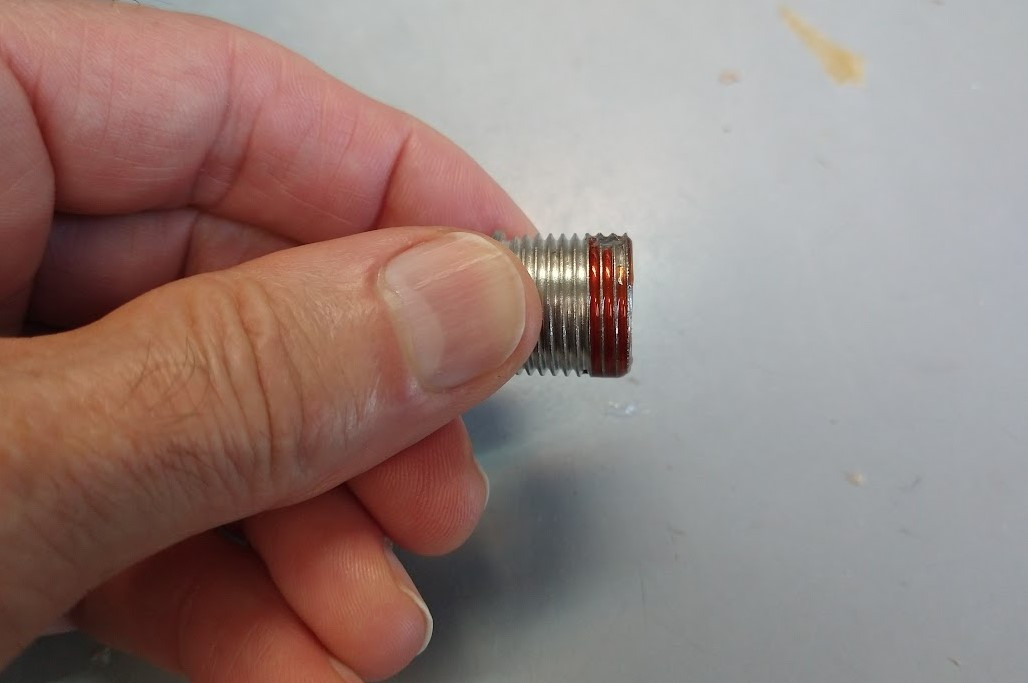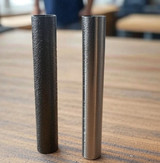Thread Locker for Spark Plug Thread Repair Insert and Proper Application
All thread lockers are not created equal. Most of us know that blue thread lockers are a temporary type that are made to hold things that you want to remove later without applying heat. And that red is a permanent type that is used on things that we probably would never want to take apart again. We recently had a customer that said his mechanic was using green because it's stronger than red. But what type of thread locker is really best for a spark plug thread repair insert? How much do you apply? In this article we cover some of the most common questions that we've had over the years regarding thread locker and spark plug thread repair. We'll also make sense of how much to use.
First let's understand how this stuff works. We think of thread locker as some sort of glue, but there's actually some science behind it. We tend to avoid technical jargon, so stay with me and in the next few minutes I promise you won't feel like you're reading a TDS - Technical Data Sheet.
Anaerobic thread lockers are the type of thread lockers that require the absence of air/oxygen to cure properly. When applied to metal threads and confined in the absence of air, such as within a joint or assembly, anaerobic thread lockers undergo a chemical reaction that results in the curing process. This reaction is triggered by the absence of oxygen and the presence of metal ions, typically from the metal surfaces themselves. The anaerobic thread locker fills the gaps between the threaded parts, creating a strong, reliable, and vibration-resistant bond.
Different types of thread locker.
Thread lockers come in different colors, each indicating a specific strength and suitability for various applications. Here's a breakdown of the common color classifications and their compatibility with spark plug inserts: Blue thread lockers are typically low-strength or removable type. Blue thread lockers provide a light locking effect and are ideal for applications allowing disassembly. Blue thread lockers are commonly used on fasteners that may require frequent removal or adjustment without excessive force or heat. However, it's important to know that blue thread lockers are generally not best for spark plug inserts, since the last thing we want is for those to come back out! For that reason, the low-strength nature of blue thread lockers may not provide the necessary secure bond required for spark plug insert applications, which experience high levels of vibration and heat from the combustion chamber.
Green thread lockers are high-strength variants designed to provide a strong and permanent bond. But here's the problem: Green thread lockers are very thin and are designed to be used after the installation. Green thread locker, due to its low viscosity, can wick down into the threads and spread too thinly if applied directly to the insert before installation. This would potentially lead to insufficient coverage and a weaker bond.
Red thread lockers are considered to be a permanent type. It's important to know that not all red thread lockers are good for up to 450-500 degrees like Time-Sert 6020 and Seal Tite 266. When using one of these High Temp thread lockers, their strength provides the necessary secure locking effect to keep the insert firmly in place, withstanding the vibrations and temperature fluctuations encountered in spark plug applications. We say they're considered permanent because if needed; an insert could be removed with some effort. Applying heat to the insert would help to weaken the bond created by the red high temp thread locker. This can be done by using methods such as a heat gun, a propane torch, or an induction tool. By applying heat, the insert and the surrounding area, the thread locker's strength is reduced, allowing for disassembly with less risk of damaging the threads. It's also important to choose one that is oil resistant, also like Seal-Tite.
How much to use.
If you're using Seal Tite thread locker or equivalent, it's natural to want to use more rather than less, thinking that it will ensure a stronger bond for your spark plug insert. However, it's important to know that more isn't always better. In fact, these types of anaerobic thread lockers are made to fill small gaps in threads, so a little goes a long way.
Applying an excessive amount of thread locker can result in it spreading beyond the required surfaces. Any extra thread locker that is on the outside of the area where curing occurs, where air is still present, will remain in liquid form and fail to cure properly. This would make most people think that the thread locker is no good or outdated because it may appear wet even after 24 hours.
To get the best bond, it's best to apply a modest quantity of thread locker to the area where you'll secure the spark plug insert. A small amount will provide the necessary strength. I like to apply some all the way around the bottom of the insert. When screwing the insert in, the sealer will be distributed evenly on the threads without over-applying.
Lack of Preparation
While Seal Tite thread locker is oil resistant, it's best not to underestimate the importance of proper preparation. Before applying the thread locker, take the time to thoroughly clean it to prevent any contaminants from coming into contact with the adhesive. Applying thread locker to dirty threads will prevent it from adhering properly. Any grease, dirt, or oil contamination may also reduce or slow down the curing process. This can result in a weaker bond, preventing the thread locker from reaching its full holding potential. I like to use some brake cleaner and then dry with compressed air. Keep in mind that excessive brake cleaner usage could leak down past the piston ring and into the crankcase. So if using a lot of brake clean, change the oil after the job is all done.
Curing Time
For optimal performance, it's best to allow Seal Tite thread lockers to fully cure after application. That would be 24 hours. However, if the vehicle is needed to be put back in service faster, many techs would start the truck only a few minutes after installation. The sealer will have plenty of time to cure before the next plug change.
Question - Who invented thread locker?
Thread locker was first invented in 1953 by Dr. Vernon K. Krieble, the founder of the company now known as Permatex. Dr. Krieble developed a revolutionary adhesive called "Loctite," which was an anaerobic liquid sealant designed to prevent threaded fasteners from loosening due to vibration and thermal cycling.
Question - Is thread locker just another glue?
Thread locker is not just another type of glue. While both thread locker and glue are adhesives, they serve different purposes and have distinct characteristics.
Question - Why wouldn't super glue work to hold in a spark plug insert?
Super glue, also known as cyanoacrylate adhesive, is not suitable for holding spark plug inserts due to several reasons:
Lack of Vibration Resistance: Spark plug inserts are subjected to significant vibrations and thermal cycling in engine applications. Super glue does not possess the same level of vibration resistance as thread lockers specifically designed for such conditions. Over time, the vibrations can cause the bond created by super glue to weaken or fail, leading to potential loosening of the insert.
Question - Does the thread locker prevent proper grounding?
It's natural to think that thread locker, when applied to the exterior threads of a spark plug insert, could potentially create an insulated layer between the metal surfaces and affect the electrical conductivity for grounding purposes. However, thread locker on the external threads of a spark plug insert should not prevent the grounding path because it only fills gaps and does not prevent all metal-to-metal contact. This contact is sufficient for the grounding needed and, therefore, does not cause problems with grounding or misfires.
Question - Should I put some blue thread locker on the spark plug?
No, it is not recommended to use any thread locker on the spark plug. Applying any thread locker to the spark plug threads can make it difficult to remove it in the future, potentially leading to damage to threads or breakage of the spark plug.
Question - Does TIME-SERT recommend using thread locker on taper seat inserts?
Yes. According to Time Sert, they recommend using thread sealer/locker on the exterior threads of taper seat spark plug inserts. However, they do not say there's a need for thread locker on washer seat inserts. Taper seat spark plugs tighten down in the seat of the insert, while washer seat inserts are flush with the surface that results in the washer seat spark plug contacting with the head during tightening, similar to a bolt. To ensure additional security and strength, it is advisable to apply thread locker on both taper and washer seat inserts.
Question - The bottle has air in it. Why doesn't the thread locker dry up in the bottle?
Thread locker typically doesn't dry up or cure inside the bottle because it requires specific conditions to initiate the curing process. Anaerobic thread lockers require the absence of air (oxygen) and the presence of metal ions to cure properly. As long as the thread locker remains sealed inside the bottle, preventing exposure to the combination of air and metal surfaces, it will remain in a liquid state. Only when it is applied to metal threads and confined in the absence of air, such as within a joint or assembly, will the curing process be triggered, resulting in the formation of a strong bond. However, it's important to ensure that the bottle is properly sealed after each use to prevent air from entering and potentially affecting the thread locker's performance over time.
Whether using Seal-Tite 266, Time Sert 6020, or Loctite 273, it's best to follow the same basic ideas laid out here. The information provided, along with the image demonstrating the proper amount of thread locker to be used, hopefully helps to make sense of thread lockers and their differences. Our slogan here at Wise Auto Tools is FIX MORE! But when it comes right down to it, you also gotta do it right.
Since 2005, we've been providing our customers with specialty tools and thread repair kits. If you are unsure which thread repair kit is the best fit for your specific application, we encourage you to reach out to us for assistance. By calling our toll-free number at 800-734-8665 or filling out our Contact Form, our team of experts can help you choose the appropriate kit. Our goal is to ensure that you have the tools and support you need to successfully complete your project with ease and confidence. Be sure to book mark us and keep us in mind for your future automotive tool needs.
Recent Posts
-
Debunking Myths: Is Stainless Steel Just Carbon Steel with Rust Protection?
Hello, I'm Dennis Bandy, owner of Wise Auto Tools and a Master Automotive Technician with many years …15th Jul 2025 -
Head Bolt Stripping in Kia and Hyundai Engines: How Common Is It and How to Fix It
A customer recently emailed us with a great question: “What percent of Kia vehicles would you say ha …9th Jul 2025 -
Pentastar 3.6L Head Bolt Thread Repair on a Budget
We recently received a great question from Michael, a DIYer facing a common problem of stripped thre …19th Mar 2025




